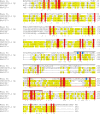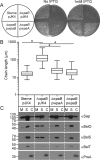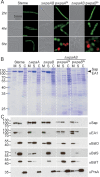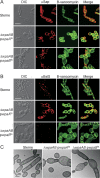Genes Required for Bacillus anthracis Secondary Cell Wall Polysaccharide Synthesis
- PMID: 27795328
- PMCID: PMC5165087
- DOI: 10.1128/JB.00613-16
Genes Required for Bacillus anthracis Secondary Cell Wall Polysaccharide Synthesis
Abstract
The secondary cell wall polysaccharide (SCWP) is thought to be essential for vegetative growth and surface (S)-layer assembly in Bacillus anthracis; however, the genetic determinants for the assembly of its trisaccharide repeat structure are not known. Here, we report that WpaA (BAS0847) and WpaB (BAS5274) share features with membrane proteins involved in the assembly of O-antigen lipopolysaccharide in Gram-negative bacteria and propose that WpaA and WpaB contribute to the assembly of the SCWP in B. anthracis Vegetative forms of the B. anthracis wpaA mutant displayed increased lengths of cell chains, a cell separation defect that was attributed to mislocalization of the S-layer-associated murein hydrolases BslO, BslS, and BslT. The wpaB mutant was defective in vegetative replication during early logarithmic growth and formed smaller colonies. Deletion of both genes, wpaA and wpaB, did not yield viable bacilli, and when depleted of both wpaA and wpaB, B. anthracis could not maintain cell shape, support vegetative growth, or assemble SCWP. We propose that WpaA and WpaB fulfill overlapping glycosyltransferase functions of either polymerizing repeat units or transferring SCWP polymers to linkage units prior to LCP-mediated anchoring of the polysaccharide to peptidoglycan.
Importance: The secondary cell wall polysaccharide (SCWP) is essential for Bacillus anthracis growth, cell shape, and division. SCWP is comprised of trisaccharide repeats (→4)-β-ManNAc-(1→4)-β-GlcNAc-(1→6)-α-GlcNAc-(1→) with α-Gal and β-Gal substitutions; however, the genetic determinants and enzymes for SCWP synthesis are not known. Here, we identify WpaA and WpaB and report that depletion of these factors affects vegetative growth, cell shape, and S-layer assembly. We hypothesize that WpaA and WpaB are involved in the assembly of SCWP prior to transfer of this polymer onto peptidoglycan.
Keywords: Bacillus anthracis; S-layers; Wzy repeat polymerase; cell wall polysaccharide; envelope assembly.
Copyright © 2016 American Society for Microbiology.
Figures









References
-
- Salton MRJ. 1964. The bacterial cell wall. Elsevier, Amsterdam, Netherlands.
-
- Kojima N, Araki Y, Ito E. 1983. Structure of linkage region between ribitol teichoic acid and peptidoglycan in cell walls of Staphylococcus aureus H. J Biol Chem 258:9043–9045. - PubMed
Publication types
MeSH terms
Substances
Grants and funding
LinkOut - more resources
Full Text Sources
Other Literature Sources

